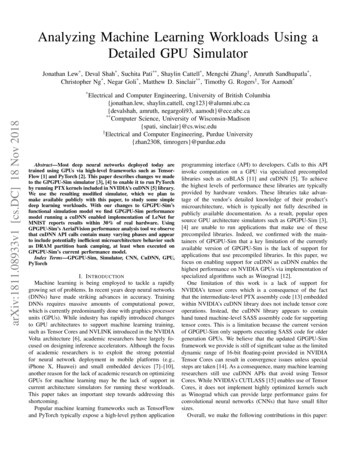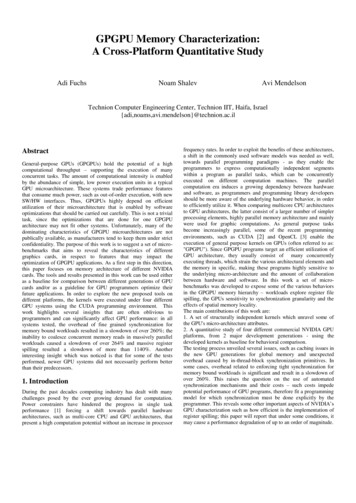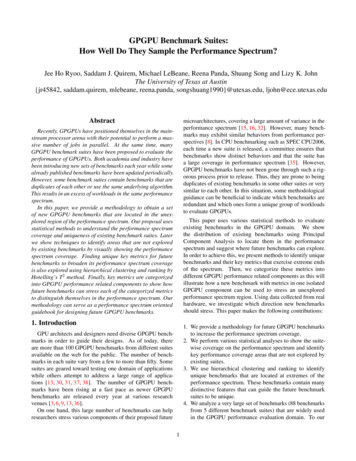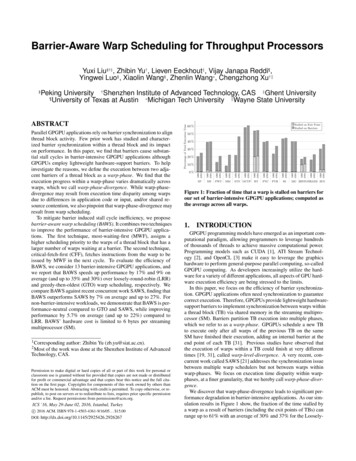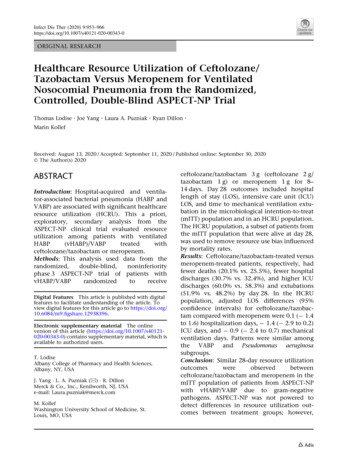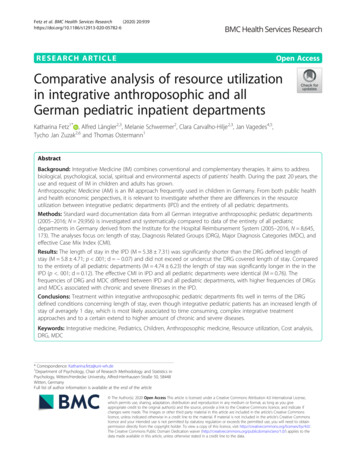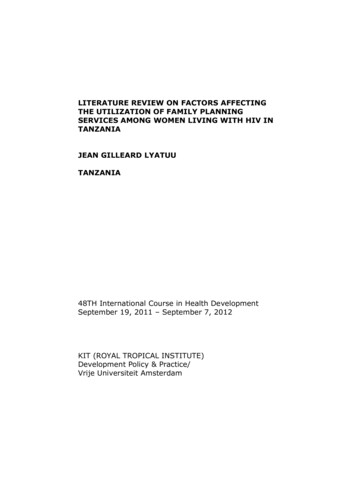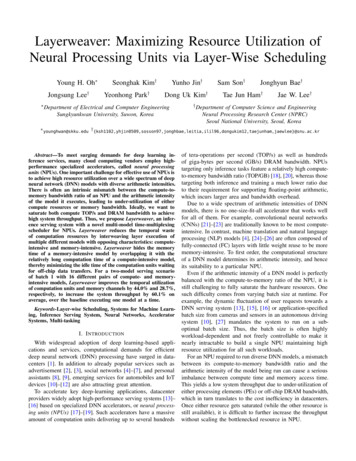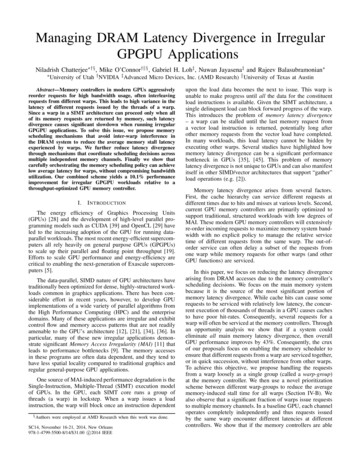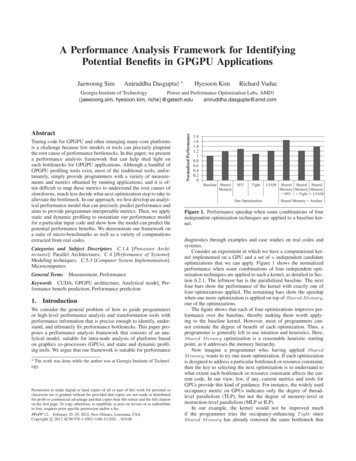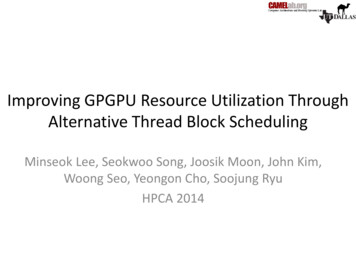
Transcription
Improving GPGPU Resource Utilization ThroughAlternative Thread Block SchedulingMinseok Lee, Seokwoo Song, Joosik Moon, John Kim,Woong Seo, Yeongon Cho, Soojung RyuHPCA 2014
Outline MotivationBackgroundLazy CTA SchedulingBlock CTA SchedulingEvaluationConclusion
Motivation A collection of threads are grouped to form a warp/wavefront,and the warps are combined to create a CTA (cooperativethread array)/thread block. As a result, there are two level of schedulers within a GPGPU:– Thread block/CTA scheduler: assign CTAs to cores– Warp/wavefront scheduler: determine which warp is executed There has been work on different warp schedulers: cacheconscious wavefront scheduling, two-level warp scheduling,etc., but few work on CTA scheduling.
Motivation Performance of different workloads as the maximum number of CTAsallocated to each core is varied For some workloads (e.g., EIP, KMN, BFS), the performance actuallydegrades as the number of CTAs assigned to a core continues to increase,which may create resource contention. This paper proposes an approach of considering both warp scheduler andblock scheduler to improve the efficiency in GPGPU architecture.
Background Baseline GPU CTA scheduling– CTAs are assigned to each SM (stream multiprocessor)/core in around-robin manner; assign the maximum number of CTAs toeach core– The maximum number of CTAs assigned to each core dependson the resource usage of the workload (the amount of registers,shared memory, etc.)– Once a particular CTA finishes, the CTA scheduler assignsanother CTA to that particular SM, until all CTAs have beenassigned to the cores
Workload characteristic Type I : Increased PerformanceType II : Increased Performance and SaturateType III : Decreased PerformanceType IV : Increase then Decrease
Lazy CTA Scheduling for type-II Goal: reduce the number of thread blocks allocated to each coredynamically and maximize performance RR vs GTO (greedy-then-oldest) warp scheduler GTO prioritizes a single warp until it stalls, and then selects the oldestwarp. As a results, GTO ends up prioritizing a single thread block until allwarps in the given thread block are stalled – and then, selects a warp fromthe oldest thread block. First thread block finishes: RR – each thread block will likely have issued asimilar number of instructions; GTO – the number of instructions executedfor each thread block will differ. For GTO, 3 CTAs are sufficient for this workload. Type-II: performance saturates with additional thread blocks
Lazy CTA Scheduling for type-III/IV RR vs GTO (greedy-then-oldest) warp schedulerCache missCache hit Assume: 3 MSHR entry/core: since all CTAs initially generates a memoryaccess, the fourth CTA cannot issue its memory instruction. Assume: CTA1 and CTA3 memory access creates an access to the samecache entry and results in a conflict miss GTO: three thread blocks are sufficient to keep the core busy; the reducednumber of thread blocks avoid the cache eviction that occur betweenCTA1 and CTA3 and avoid performance degradation
Three phases of Lazy CTA Scheduling Phase 1: Monitor– Tmax thread blocks are initially allocated to each core– the number of instructions issued (inst) for each thread block x ismeasured until the first thread block finishes execution Phase 2: Throttle– total number of instruction issued across all the thread blocks inthe core / the number of instructions issued from the firstthread block that completed– e.g. in figure(b): Tnew 10/4 3 Phase 3: Lazy Execution– Only Tnew thread blocks allocated to each core after Phase 2 completes The algorithm is repeated for each kernel within each workload since thebehavior of each kernel can differ.
Block CTA Scheduling Many workloads (kernels) in GPGPU workloads are organized as a 2D arrayof CTAs; common CTA size: 16 16 (256 threads); Inter-CTA locality can exist among sequential CTAs :Data accessed by each thread – a single word (4Bytes);Each row of data from a CTA – 16 4 64 Bytes;The line size of L1 cache – 128Bytesspatial locality exists between neighboring CTAs With RR block scheduling, the inter-CTA spatial locality is lost sincesequential CTAs are not assigned to same core
Block CTA Scheduling Assigns a block (e.g. 2) of sequential thread blocks or CTAs to the samecore; exploit spatial locality across the same cache line within the local L1 Delayed scheduling/assignment of thread blocks: a new thread block isnot allocated to a core until pair of sequential thread blocks finishexecution Sequential CTA-aware(SCA) warp scheduling to effectively exploit theinter-CTA locality with BCS– Warps are scheduled in a round-robin manner between two warps ofneighboring thread blocks or within a block– The warp scheduler remains greedy as these set of warps areprioritized, until one of the two warps stall.– Then, the next group of warps within the same block is scheduled. BCS is not applicable to workloads with one-dimensional CTAs as there islittle inter-CTA L1 locality.
Evaluation Lazy CTA Scheduling Results Baseline: greedy-then-oldest warp scheduler; RR CTA scheduler 7% improvement on average; 23% improvement for Type-III/IVFor some workloads, thenumber of optimal threadblocks determined by LCS wassmaller than OPT value.Modification: 𝑇𝑛𝑒𝑤 𝑇𝑛𝑒𝑤
Evaluation Block CTA Scheduling Results (for only 2D workloads) On average, 3% for BCS GTO; 15% for BCS SCA On average, L1 miss rate reduced by 8% for BCS GTO; 24% for BCS SCA Delayed thread block assignment (in order to assign consecutive CTAs tothe same core) may negate the benefit from reduced miss rate.
Conclusion LCS (lazy CTA scheduling): leverage a greedy warp schedulerto determine the optimal number of thread blocks per core BCS (block CTA scheduling): exploit inter-CTA locality toimprove overall performance– alternative warp scheduler: aware of the consecutive thread blocksallocated to the same core and exploit the inter-CTA locality
Backup
mixed Concurrent Kernel Execution (mCKE) Allocate less than the maximum number of thread blocks toeach coreunderutilized resources within a coreopportunity for concurrent execution of different kernels onthe same core In the baseline CKE, each core can be stalled at different time point With mCKE, the memory latency can be hidden (or overlapped) with otherkernel execution
Evaluation Mixed Concurrent Kernel Execution Results Merge different workloads The number of CTAs allocated to each core is based on the optimalnumber of thread blocks from LCS For the baseline CKE, the LCS was used such that the optimal number ofthread blocks were allocated. For a given workload, the benefit of mCKE depends on which workload itis mixed with
As a result, there are two level of schedulers within a GPGPU: -Thread block/CTA scheduler: assign CTAs to cores -Warp/wavefront scheduler: determine which warp is executed There has been work on different warp schedulers: cache-conscious wavefront scheduling, two-level warp scheduling, etc., but few work on CTA scheduling.
